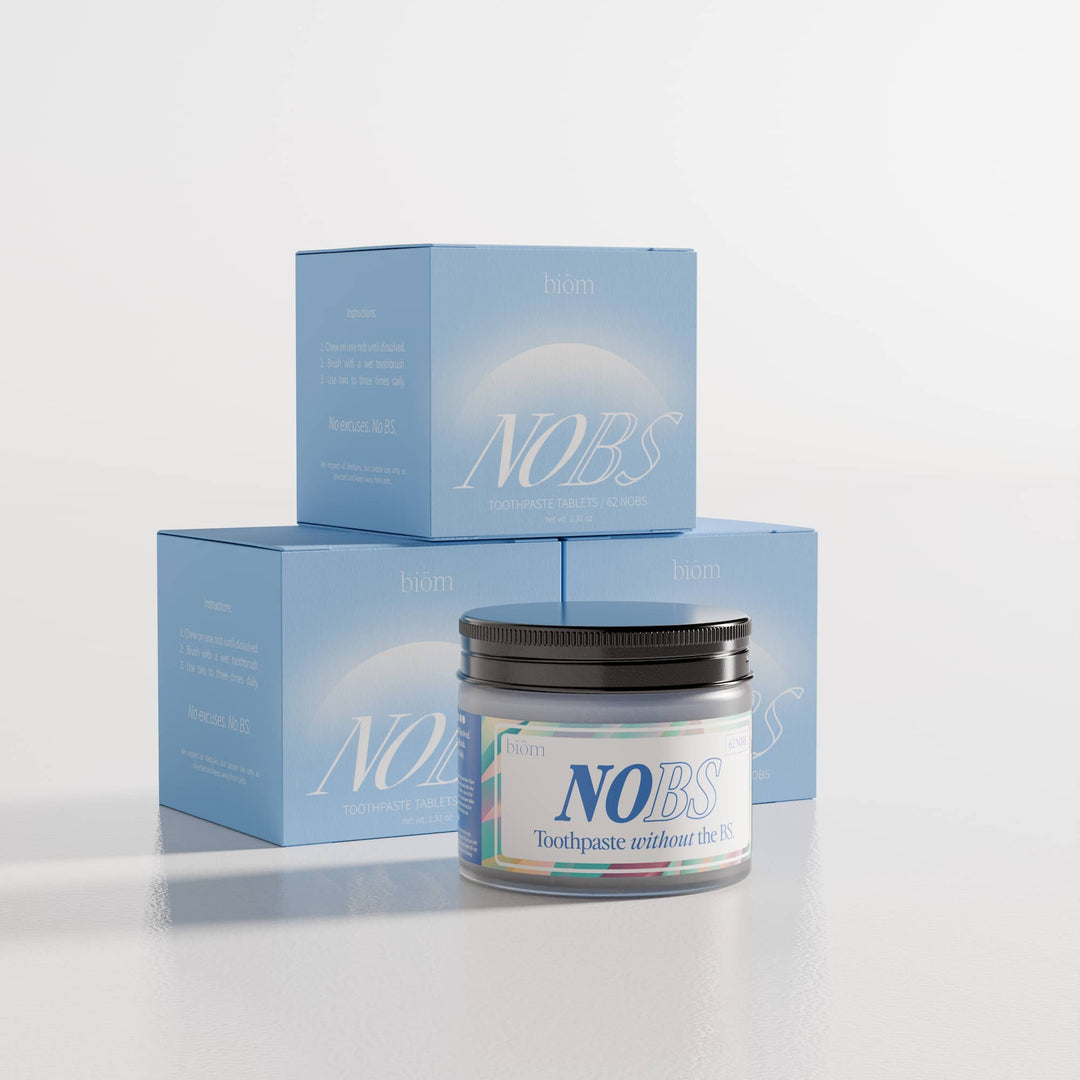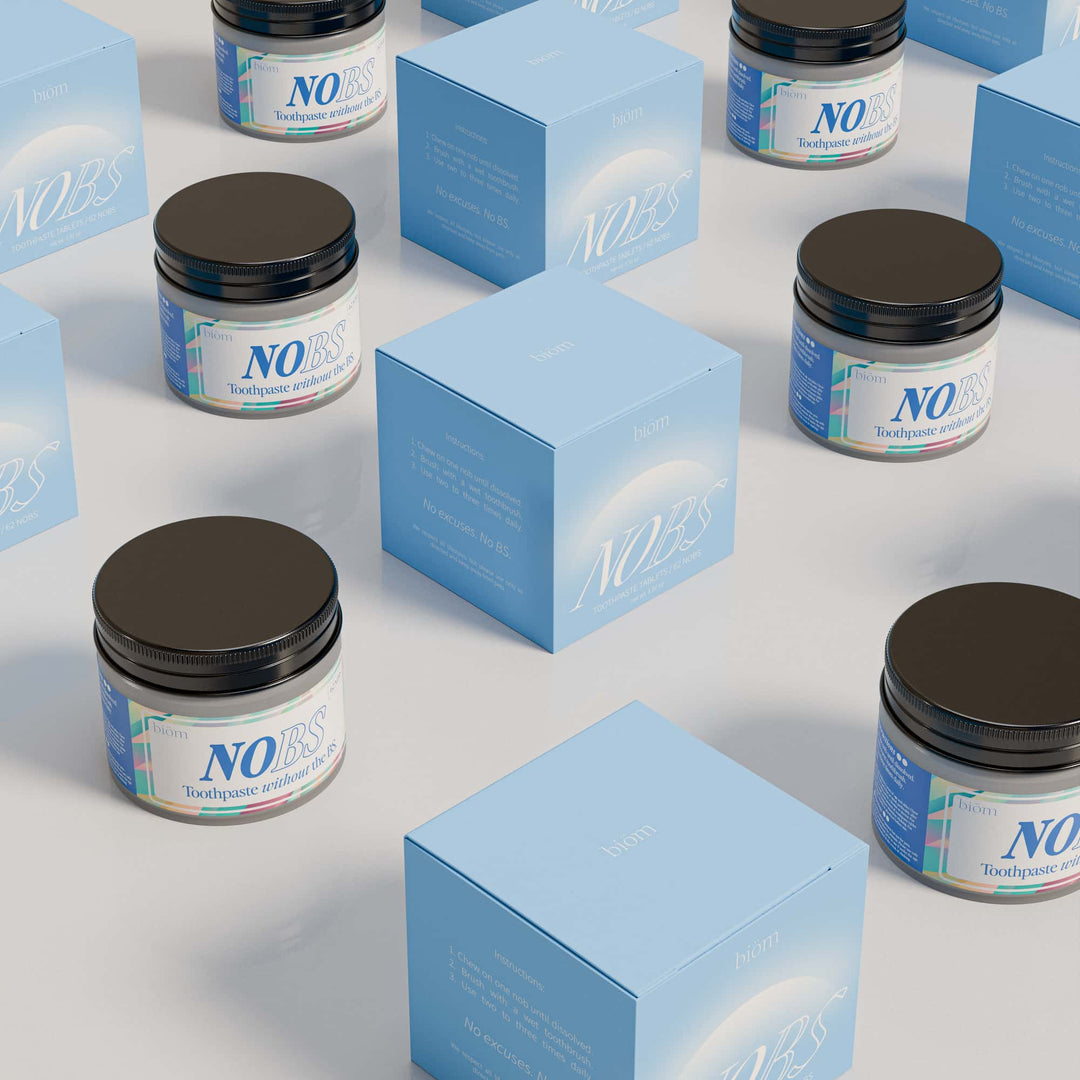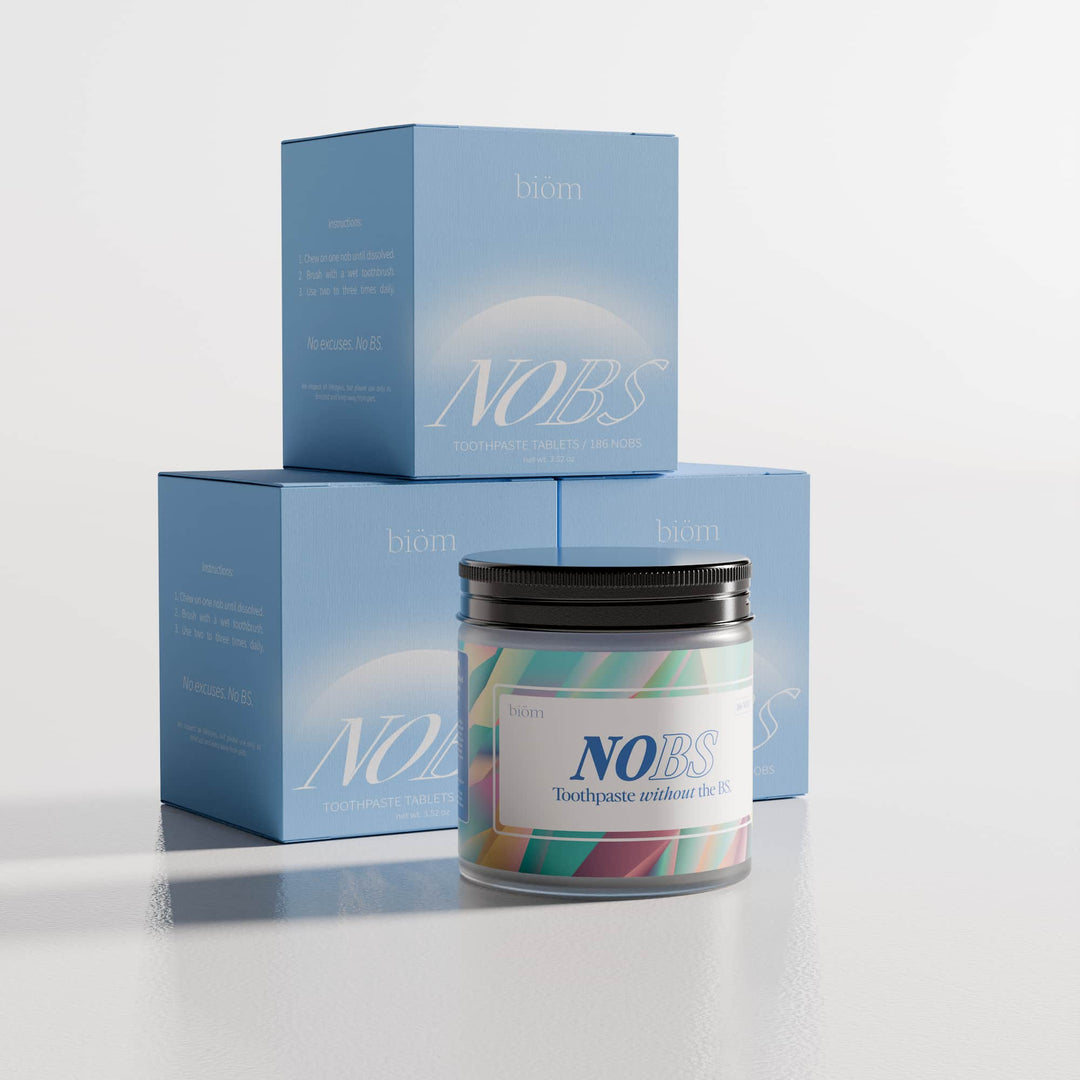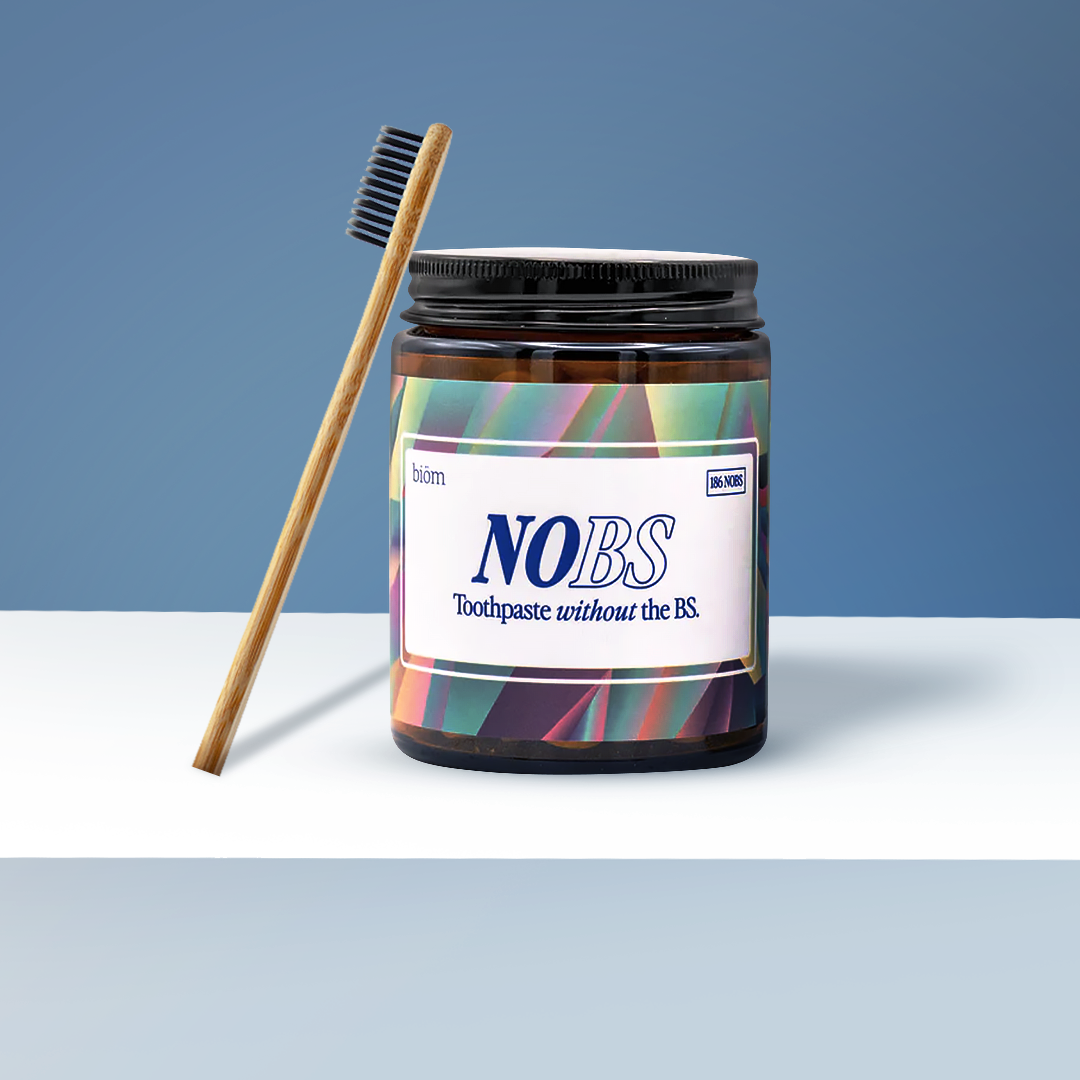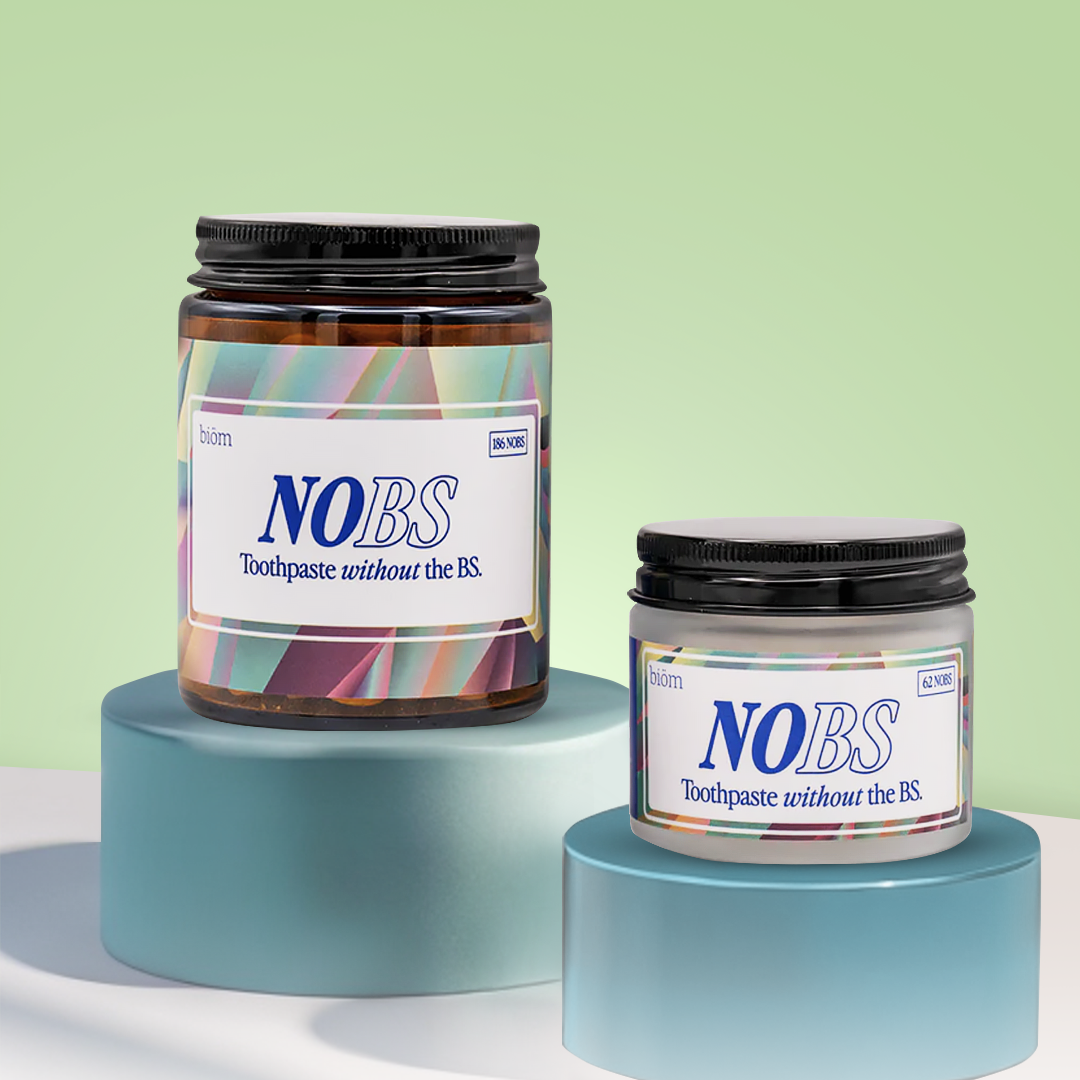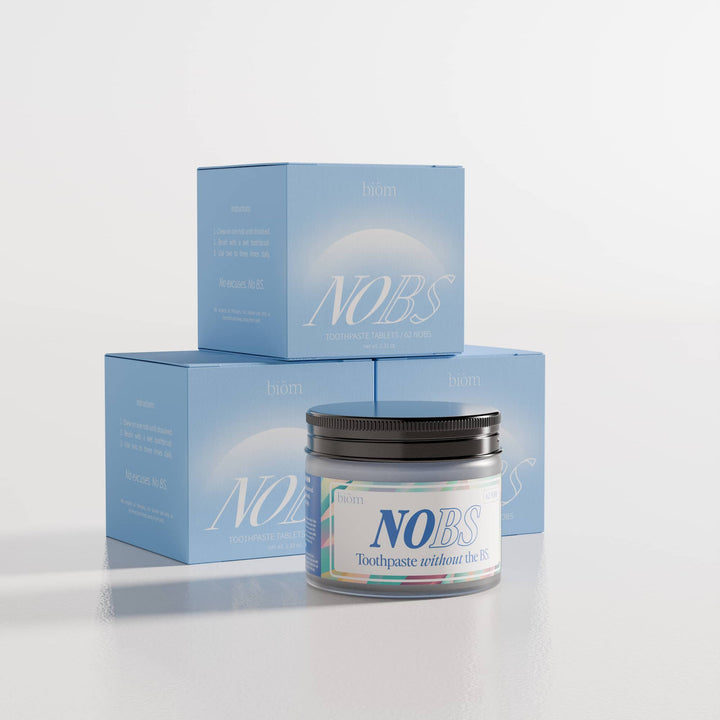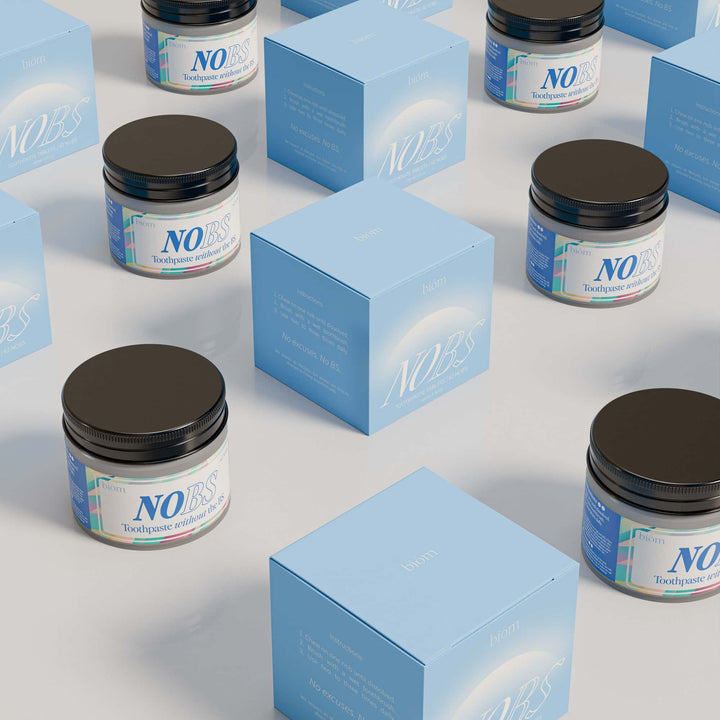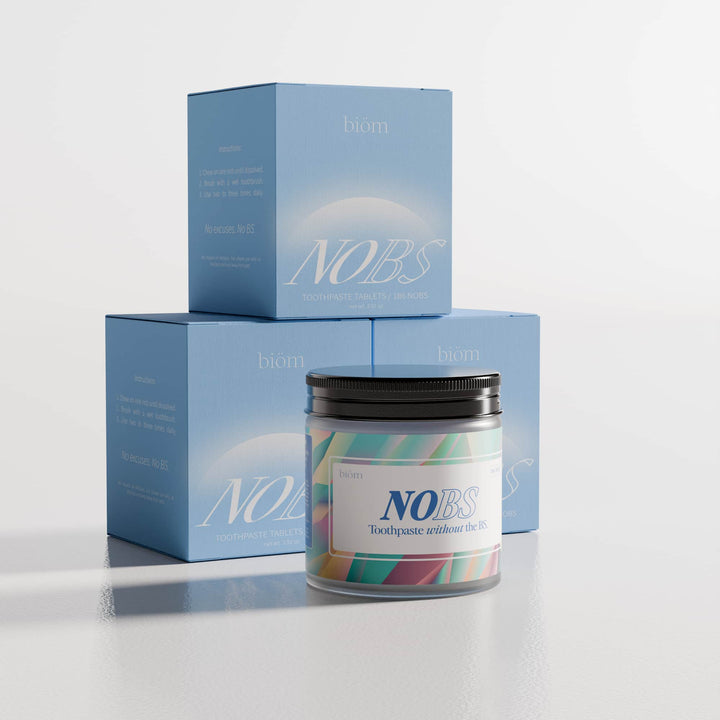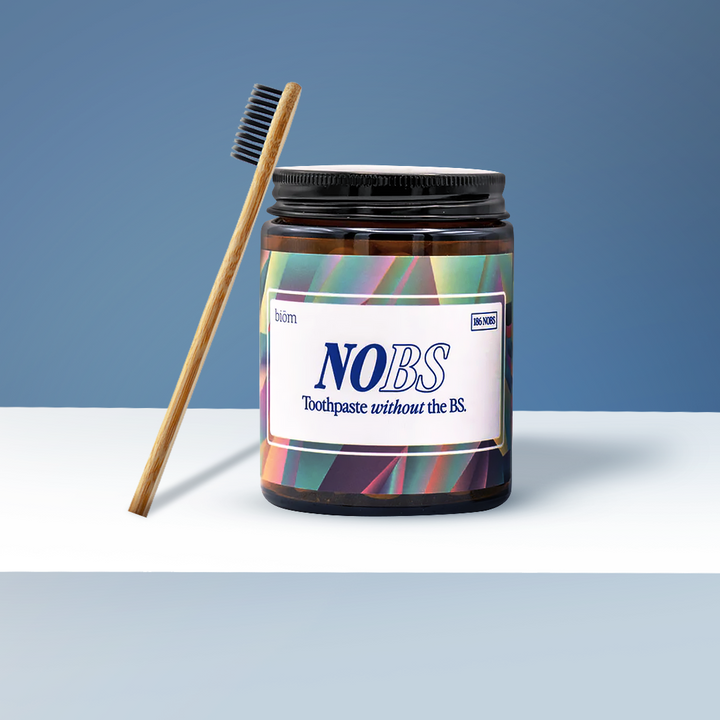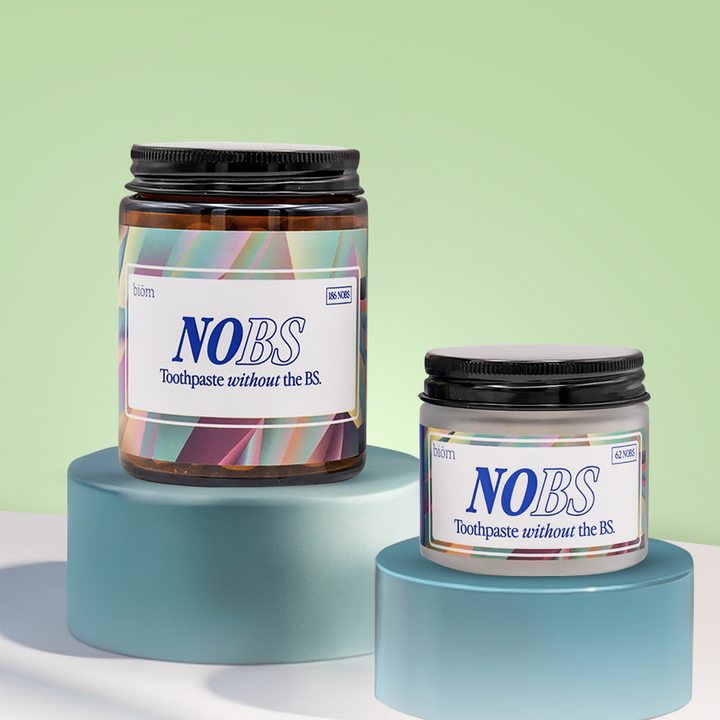Is Hydroxyapatite Better Than Fluoride?
Yes, hydroxyapatite can be considered better than fluoride in toothpaste due to its equal efficacy in remineralizing teeth while also providing a reduced risk of adverse effects.
Fluoride has been the gold standard in oral care for decades due to its proven ability to prevent tooth decay by strengthening enamel and inhibiting bacterial growth. That's why you'll commonly find it in toothpaste, mouthwash, and professional treatments.
However, concerns have been raised about potential side effects of fluoride, such as dental fluorosis and toxicity, especially with excessive intake. For this reason, many people consider fluoride to be an ingredient to avoid in toothpaste.
On the other hand, hydroxyapatite is a naturally occurring mineral that makes up the majority of tooth enamel. Essentially, hydroxyapatite toothpaste works by remineralizing enamel and restoring its strength and integrity. It is known for being biocompatible and safe with fewer side effects compared to fluoride.
While both ingredients are effective in promoting oral health, hydroxyapatite is typically preferred by those looking for a fluoride free toothpaste alternative or those concerned about potential side effects of fluoride.
Additionally, hydroxyapatite has shown promising results or remineralizing enamel and preventing tooth decay, making it a viable alternative to fluoride-based products.
In this article, I'll explain everything you need to know about hydroxyapatite, fluoride, and which one is right for you.
What is hydroxyapatite toothpaste?

Hydroxyapatite toothpaste is a type of toothpaste that contains hydroxyapatite as its active ingredient.
Hydroxyapatite is a naturally occurring mineral that is the primary component of tooth enamel, the hard outer layer of the teeth. In toothpaste, hydroxyapatite serves to remineralize enamel, strengthen teeth, and protect against tooth decay.
Hydroxyapatite-based toothpaste, including nano hydroxyapatite toothpaste, works by depositing hydroxyapatite particles onto the tooth surface, where they integrate into the enamel structure and help restore lost minerals. By replenishing calcium and phosphate ions, hydroxyapatite toothpaste promotes the repair of microscopic enamel imperfections and increases enamel resistance to acid erosion.
Hydroxyapatite toothpaste is known for its ability to support enamel remineralization and soothe hypersensitivity. It's a preferred choice by individuals seeking fluoride-free toothpaste, as hydroxyapatite closely mimics the mineral composition of our teeth and is well-tolerated by most people.
Beyond toothpaste, hydroxyapatite is also used for various medical and dental capacities.
How does hydroxyapatite toothpaste work?
Hydroxyapatite toothpaste works through its ability to stimulate a process called remineralization. Essentially, hydroxyapatite particles restore and strengthen our tooth enamel by depositing calcium phosphate ions.
You see, when our enamel is exposed to acids produced by the bacteria that naturally live in our mouths or dietary acids/sugars, it can become demineralized. This leads to weakened enamel, tooth sensitivity, and tooth decay. If left untreated, that tooth decay can progress into full blown dental caries.
Since hydroxyapatite is a biomimetic compound and closely mimics the natural mineral composition of our teeth, it is easily able to remineralize enamel and protect us from all kinds of dental issues.
Studies also show that hydroxyapatite toothpaste can prevent plaque buildup which can otherwise lead to tartar development and cavities. Further, more research suggests that hydroxyapatite can also whiten teeth as the remineralization process may remove surface stains.
Benefits of Hydroxyapatite Toothpaste
Hydroxyapatite toothpaste offers a range of benefits that contribute to overall oral health and hygiene. These benefits include:
-
Remineralization: Hydroxyapatite toothpaste aids in the remineralization process, restoring lost minerals to the tooth enamel and strengthening it against acid erosion and decay. By replenishing calcium and phosphate ions, hydroxyapatite supports the repair of microscopic enamel imperfections, promoting healthier teeth.
-
Strengthening Enamel: The main component of hydroxyapatite is a naturally occurring mineral found in teeth and bones, making it an ideal ingredient for fortifying enamel. By integrating into the tooth structure and increasing the mineral density of your teeth, hydroxyapatite reinforces enamel strength and resilience, reducing the risk of damage and decay.
-
Preventing Tooth Decay: Hydroxyapatite toothpaste forms a protective layer on the tooth surface, covering demineralized enamel and shielding it from acid attacks and bacterial growth. This barrier helps prevent demineralization and reduces the formation of plaque and tartar, lowering the likelihood of developing tooth decay and other dental issues.
-
Brightening Teeth: Hydroxyapatite toothpaste gently polishes the tooth surface, effectively removing surface stains caused by food, beverages, and tobacco. While its primary function is not solely focused on whitening, hydroxyapatite can whiten teeth by restoring enamel health and promoting overall oral hygiene.
-
Fighting Hypersensitivity: Hydroxyapatite toothpaste has been shown to be effective in reducing dentin hypersensitivity by covering exposed dentinal tubules and blocking sensations from reaching the tooth nerve. By providing a protective barrier, hydroxyapatite toothpaste can alleviate discomfort associated with hot, cold, or sweet stimuli, improving oral comfort for individuals with sensitive teeth.
Overall, hydroxyapatite toothpaste offers a holistic approach to oral care, addressing multiple aspects of dental health while minimizing potential side effects commonly associated with other toothpaste formulations.
Side Effects of Hydroxyapatite Toothpaste

Hydroxyapatite toothpaste is generally considered safe and well-tolerated for most individuals, with few reported side effects.
Research states that there is no literature reporting any systemic or adverse effects of hydroxyapatite containing toothpastes. One paper even states: "Thus far in the literature, there have been no reports of adverse dental or systemic effects of HAP-containing toothpastes because HAP has an excellent biocompatibility".
Further, one study found that hydroxyapatite nanoparticles possess no irritation potential, meaning they're gentle enough to use on the delicate tissues in your mouth.
In fact, the lack of side effects and toxicity is why many people are turning to nano hydroxyapatite toothpaste as a safe, non-toxic alternative to fluoride toothpaste.
Of course, there may be isolated cases of individual allergic reactions or sensitivities to certain ingredients in toothpaste, but because hydroxyapatite is the material our teeth and bones are already made of, this concern is exceedingly rare.
What is fluoride toothpaste?
Fluoride toothpaste is a type of toothpaste that contains fluoride as its active ingredient.
Fluoride is a naturally occurring mineral found in soil, water, and certain foods. In oral care products, fluoride is added in the form of sodium fluoride, sodium monofluorophosphate, or stannous fluoride to help prevent tooth decay and cavities.
Fluoride toothpaste works by incorporating fluoride ions into your enamel, making it stronger and more resistant to acid attacks from plaque-causing bacteria. This process, known as remineralization, strengthens the enamel and reduces the risk of tooth decay.
Additionally, fluoride toothpaste may also inhibit the growth of bacteria in the mouth and reduce the production of acids that can erode tooth enamel, further contributing to cavity prevention.
Regularly using remineralizing toothpaste with fluoride or nano hydroxyapatite alongside expandable floss, tongue scraping, and using alkaline mouthwash can help support overall oral health and reduce your risk of developing tooth decay.
Why is fluoride the gold standard in toothpaste?

Fluoride has long been regarded as the gold standard in toothpaste due to its proven ability to prevent cavities and promote oral health.
Initially discovered for its cavity-preventing properties, fluoride was widely adopted in oral care products and public health initiatives, including water fluoridation programs. The implementation of fluoride in water supplies significantly reduced cavity rates and improved dental health outcomes across populations.
However, advancements in technology and scientific understanding have led to the development of alternatives like nano hydroxyapatite, which offer comparable remineralization potential without some of the potential side effects associated with fluoride.
While fluoride remains effective in strengthening enamel and inhibiting bacterial growth, concerns have arisen regarding its long-term safety and potential adverse effects, such as skeletal fluorosis and cognitive impacts in children.
As research continues to evolve, there is growing recognition of the need to explore alternative approaches to dental care that balance efficacy with safety.
Nano hydroxyapatite, a more effective derivative of hydroxyapatite, has emerged as a better alternative to fluoride toothpaste due to its safety profile.
How does fluoride toothpaste work?

Fluoride toothpastes work primarily by remineralizing and strengthening tooth enamel, which is the protective outer layer of our teeth.
When you brush with fluoride toothpaste, fluoride ions can be absorbed into the enamel, forming a compound known as fluorapatite. This compound is more resistant to acid attacks from bacteria in plaque and reduces your chances of enamel demineralization and developing tooth decay.
Additionally, fluoride can repair early stages of tooth decay and control dental caries by promoting remineralization, where minerals are deposited back into areas of weakened enamel, restoring its strength.
Furthermore, fluoride can inhibit the growth of bacteria that cause dental plaque and reduce their ability to produce acids that can erode tooth enamel. By disrupting the bacteria's metabolic processes, fluoride supports a balanced oral environment and reduces your risk of developing cavities.
That said, it's worth noting that you cannot remineralize a cavity once it has already formed.
Overall, fluoride works through multiple mechanisms, including:
-
strengthening enamel
-
promoting remineralization
-
inhibiting bacterial growth
-
and reducing acid production,
making it an effective tool in preventive dental care.
Benefits of Fluoride Toothpaste
Fluoride toothpaste's primary benefit lies in strengthening tooth enamel, the outer protective layer of your teeth, and preventing dental caries. This occurs through a process known as remineralization.
Essentially, when you brush your teeth, amine fluoride ions in the toothpaste are absorbed into the enamel, forming a compound known as fluorapatite, which is more resistant to acid attacks from plaque bacteria. This process helps with remineralizing initial caries lesions and fortifying enamel, making it less susceptible to decay and cavities.
Additionally, fluoride toothpastes repair early stages of tooth decay and inhibit the growth of bad bacteria that create dental plaque.
That said, nano hydroxyapatite toothpastes are equally as effective as fluoride toothpastes at remineralizing and strengthening teeth without the potential side effects of fluoride.
Side Effects of Fluoride Toothpaste

Fluoride, when used in appropriate amounts, is generally safe and effective for strengthening teeth and promoting overall oral health. However, excessive fluoride intake can lead to potential side effects
Dental Fluorosis
Dental fluorosis is a condition that affects the appearance of tooth enamel, typically occurring during the early stages of tooth development in childhood.
It manifests as white streaks or spots, brown discoloration, or pitting on the tooth surface. Dental fluorosis occurs when children ingest too much fluoride during tooth formation, often from swallowing fluoride toothpaste or consuming fluoridated water in excess.
While mild forms of dental fluorosis may be barely noticeable, severe cases can lead to significant aesthetic concerns and may require cosmetic dental treatment to improve the appearance of affected teeth.
Skeletal Fluorosis

Skeletal fluorosis is a bone disorder caused by long-term exposure to high levels of fluoride, typically from drinking water with naturally occurring fluoride concentrations above recommended levels.
In skeletal fluorosis, fluoride accumulates in the bones, leading to changes in bone density and structure. Symptoms of skeletal fluorosis may include joint pain, stiffness, and skeletal deformities.
While skeletal fluorosis is rare in areas with controlled fluoride levels, it remains a concern in regions where natural fluoride levels are high or in populations with excessive fluoride exposure.
Fluoride Toxicity
Fluoride toxicity occurs when individuals ingest large amounts of fluoride, either accidentally or intentionally. This can happen through the ingestion of fluoride-containing products such as toothpaste or mouthwash, especially by young children who may swallow these products instead of spitting them out.
Symptoms of fluoride toxicity may include nausea, vomiting, abdominal pain, diarrhea, and in severe cases, convulsions and cardiac arrhythmias.
While acute fluoride toxicity is rare, it can occur in cases of accidental ingestion of concentrated fluoride products or intentional misuse of fluoride supplements.
Hydroxyapatite vs. Fluoride Toothpaste

Dental professionals use fluoride and hydroxyapatite together or individually to control dental caries and for other regenerative dentistry practices.
Both hydroxyapatite and fluoride toothpastes are effective for:
-
fighting tooth decay
-
remineralizing initial caries lesions
-
preventing dental caries
-
and soothing hypersensitivity.
However, they work differently and have different implications for your holistic health. Let's walk through some of the main differences between hydroxyapatite vs fluoride.
Composition
Hydroxyapatite is a naturally occurring mineral that makes up the majority of tooth enamel and bone tissue. In oral care products, hydroxyapatite is used for its ability to remineralize enamel and promote dental health.
Fluoride, on the other hand, is a synthetic mineral compound that is widely recognized for its cavity-preventing properties. It works by strengthening enamel and inhibiting the growth of bacteria in the mouth.
How They Work

Hydroxyapatite and fluoride take different approaches when it comes to protecting our teeth.
Hydroxyapatite toothpaste works by forming a new layer of hydroxyapatite on the surface of the tooth, which integrates into the natural tooth structure, strengthening and remineralizing it.
Meanwhile, fluoride toothpaste works by being absorbed into enamel during brushing and creating fluorapatite, a substance that helps prevent tooth decay by promoting remineralization of tooth enamel.
Efficacy

When discussing the efficacy of hydroxyapatite and fluoride toothpaste, a distinction arises.
Numerous studies suggest that fluoride has long been effective in reducing caries due to its capability of integrating into the tooth enamel and fighting off harmful bacteria.
However, a recent study indicates that hydroxyapatite toothpaste is equally, if not more, effective in remineralizing initial caries lesions and reducing the formation of plaque. Further, a meta analysis concluded that, "biomimetic hydroxyapatite-containing, fluoride-free oral care products are effective in reducing dental decay, especially in children."
Finally, another study using the International Caries Detection and Assessment System concluded, at the end of a year-long trial, that hydroxyapatite toothpaste was not inferior to a fluoride control toothpaste.
Safety
While both fluoride and hydroxyapatite toothpaste are generally safe for daily use, there are certain considerations for each.
For instance, overconsumption of fluoride, especially in young children, could lead to dental fluorosis, fluoride toxicity, and more.
On the contrary, nano hydroxyapatite is biomimetic and safe as it is already a substance naturally present in our teeth, which makes it less likely to cause any harm when use.
However, as with any oral care product, some individuals may experience rare allergic reactions or sensitivities to certain ingredients in hydroxyapatite toothpaste.
Benefits

Hydroxyapatite and fluoride offer similar benefits for oral health. Both ingredients are known for their abilities to:
-
support enamel remineralization
-
prevent demineralization
-
inhibit bad bacteria
-
and prevent and reverse tooth decay.
In fact, studies show that both nano hydroxyapatite and fluoride are equally effective in toothpaste.
One benefit hydroxyapatite-based toothpastes may have over fluoride toothpaste is that hydroxyapatite is known for its ability to whiten teeth. Unlike traditional whitening toothpaste, which can be too abrasive for your teeth, hydroxyapatite toothpaste gently polishes the tooth surface, effectively removing surface stains caused by food, beverages, and tobacco.
Therefore, while hydroxyapatite's primary function isn't solely focused on whitening, it can indeed lead to a brighter smile!
Side Effects
While, both types of toothpaste are generally considered safe for regular use, excessive ingestion of fluoride can potentially lead to fluorosis - a condition that causes discoloration or spotting on the teeth.
Hydroxyapatite toothpaste, being an biomemetic substance, does not have known side effects because it's a compound your body already makes (remember, your teeth and bones are made of hydroxyapatite). In fact, research states that there is no literature reporting any systemic or adverse effects of hydroxyapatite containing toothpastes.
Ultimately, the decision to choose one over the other often boils down to personal oral care needs and your dentist advice.
Okay, so which one is better?

Hydroxyapatite can be considered better than fluoride as it offers similar benefits without the associated toxicity.
It provides the advantages of fluoride, such as tooth decay protection, sensitivity reduction, and enamel remineralization, but without the potential harm linked to fluoride ingestion.
Hydroxyapatite is non-toxic and safe enough to swallow, unlike fluoride, which can cause dental and skeletal fluorosis if overexposed.
That's why choosing hydroxyapatite can be a safer and better alternative for oral care.
However, it is always recommended to consult with a dental professional for personalized recommendations.
Are hydroxyapatite and fluoride the same?
No, hydroxyapatite and fluoride are not the same. They are two distinct compounds with different chemical compositions and functions, although they both play important roles in maintaining oral health and have similar benefits.
Hydroxyapatite is a naturally occurring mineral that constitutes the primary inorganic component of human teeth and bones. It is composed of calcium, phosphate, and hydroxide ions, forming a crystalline structure that provides strength and hardness to tooth enamel and bone tissue.
Fluoride, on the other hand, is a synthetic mineral compound that contains fluorine ions. It is widely recognized for its cavity-preventing properties and is commonly used in oral care products such as toothpaste, mouthwash, and professional dental treatments.
Both ingredients work by:
-
strengthening enamel
-
inhibiting the growth of bad bacteria in your mouth
-
promoting remineralization
-
and fighting hypersensitivity.
While both hydroxyapatite and fluoride contribute to maintaining optimal oral health, they have different mechanisms of action and are often used together or separately in oral care products to address specific dental needs.
Is fluoride better for preventing cavities than hydroxyapatite?
While only fluoride is approved by the American Dental Association for preventing cavities, studies suggest that both hydroxyapatite and nano hydroxyapatite are equally as effective as fluoride.
Hydroxyapatite has been shown to remineralize enamel, strengthen teeth, and inhibit the growth of bacteria in the mouth, making it a promising alternative or adjunct to fluoride-based oral care products.
Some studies also indicate that hydroxyapatite toothpaste is as effective as fluoride toothpaste in reducing the formation of plaque and preventing tooth decay.
Finally, another study using the International Caries Detection and Assessment System concluded, at the end of a year-long trial, that hydroxyapatite toothpaste was not inferior to a fluoride control toothpaste.
Can you use both nano-hydroxyapatite and fluoride?
Yes, you can use both nano-hydroxyapatite (nHA) and fluoride together, but their combined effects can vary based on application methods and concentrations.
Studies indicate that while both nHA and fluoride have remineralizing properties, their interaction may not always be synergistic.
For instance, research has shown that when applied simultaneously, nHA can negatively affect the stability of calcium fluoride layers formed by fluoride treatments, potentially reducing their effectiveness. However, other studies suggest that using them sequentially may yield better results, as nHA can enhance the remineralization process initiated by fluoride without compromising its benefits.
Additionally, some findings indicate that nHA may provide comparable remineralization to fluoride alone, making it a viable alternative for those looking to reduce fluoride exposure.
Overall, while both agents can be beneficial for dental health, it is essential to consider their application methods to maximize their effectiveness. Consulting with a dental professional can
Should I switch to hydroxyapatite toothpaste?
Switching to hydroxyapatite toothpaste could be a smart move, especially if you're looking for a non-toxic alternative to fluoride.
Many dentists still consider fluoride the "gold standard," but hydroxyapatite is gaining attention for its ability to remineralize teeth without toxicity.
This toothpaste is particularly recommended for pregnant women, young children, and people with sensitive teeth, as it can help reduce sensitivity by addressing the root cause.
Therefore, if you're considering the switch, it's best to have hydroxyapatite toothpaste, like NOBS Toothpaste Tablets, to feel confident and safe.
Is hydroxyapatite as good as fluoride?
Yes, hydroxyapatite is as good as fluoride in promoting dental health.
Studies have shown that it strengthens and remineralizes tooth enamel by bonding to damaged areas. Like fluoride, hydroxyapatite helps prevent cavities by reducing demineralization and encouraging enamel repair. Research indicates it also reduces tooth sensitivity by sealing exposed dentin tubules.
Additionally, hydroxyapatite is biocompatible and safe if swallowed, making it ideal for children and individuals seeking a natural alternative. Unlike fluoride, it poses no risk of toxicity from overuse.
Overall, studies confirm that hydroxyapatite is a reliable and safer option for maintaining strong and healthy teeth.
Other Tips for Good Oral Hygiene
Using hydroxyapatite-based toothpaste isn't the only way to remineralize teeth.
Maintaining strong and healthy teeth requires a combination of good oral hygiene practices and lifestyle choices. Here are some additional tips to promote strong, healthy teeth:
BRUSH WITH NANO HYDROXYAPATITE TOOTHPASTE
Nano hydroxyapatite toothpaste contains tiny particles of a mineral naturally found in teeth and bones.
Thus, brushing with nano hydroxyapatite toothpaste tablets helps strengthen enamel by depositing nano hydroxyapatite particles onto tooth surfaces. These particles bond with enamel, fill in minor surface defects, and promote remineralization.
USE EXPANDABLE FLOSS AT LEAST THREE TIMES PER WEEK
Flossing is essential for removing food particles and plaque from between your teeth and along the gumline, where your toothbrush may not be able to reach.
Expandable floss is designed to expand and adapt to the contours of your teeth, providing thorough cleaning. We recommend flossing at least three times per week (although preferably daily) to prevent prevent plaque buildup and reduce your risk of gum disease.
LIMIT ACIDIC FOODS IN YOUR DIET
As discussed earlier, acidic foods and beverages, such as citrus fruits, carbonated sodas, and certain sauces, can weaken tooth enamel and contribute to enamel erosion over time.
Limiting your consumption of acidic foods helps reduce the risk of acid-related enamel damage. If you do consume acidic items, consider rinsing your mouth with water afterward or using an alkaline mouthwash to help neutralize acids and minimize their effects on your teeth.
USE ALCOHOL-FREE MOUTHWASH
Alcohol-free mouthwash can be a gentler choice for oral care. Alcohol-based mouthwashes can sometimes lead to dry mouth, which can increase the risk of dental issues.
An alcohol-free mouthwash can help freshen your breath, reduce the growth of harmful bacteria, and provide additional support for your oral hygiene routine without causing dryness.
Plus, you can use alcohol free mouth everyday, and it's safe for kids to use too.
Can I use hydroxyapatite toothpaste everyday?
Yes, you can use hydroxyapatite toothpaste every day.
Studies indicate that hydroxyapatite is a safe and effective mineral that can help remineralize tooth enamel, strengthening teeth and preventing decay.
In contrast to fluoride, hydroxyapatite works by directly rebuilding and restoring enamel, making it suitable for daily use without concerns about overexposure. It is gentle on the teeth and gums, making it ideal for those with sensitive teeth.
Using hydroxyapatite toothpaste regularly may also help reduce tooth sensitivity over time. This type of toothpaste is a great alternative for people who prefer fluoride-free options.
Summary: Should you use hydroxyapatite toothpaste instead of fluoride toothpaste?
Yes, you should use hydroxyapatite toothpaste instead of fluoride toothpaste as hydroxyapatite toothpastes provide equal benefits with a lower risk of side effects.
Fluoride, long regarded as the standard in oral care, is prized for its ability to combat tooth decay by strengthening enamel and inhibiting the growth of bad bacteria in our mouths. However, concerns have surfaced regarding potential drawbacks of fluoride, including dental fluorosis and toxicity, particularly when consumed excessively.
In contrast, hydroxyapatite, a natural mineral constituting a significant portion of tooth enamel, serves to remineralize enamel and fortify its structure. It's a prized ingredient in hydroxyapatite toothpaste which is used in regenerative dentistry for its biocompatibility and purportedly fewer adverse effects compared to fluoride.
Ultimately, the choice between using hydroxyapatite or fluoride is up to you and your individual preferences or allergies. Of course, you can always choose to use hydroxyapatite and fluoride together in your oral care routine if you wish.
Frequently Asked Questions
Hydroxyapatite vs Fluoride: Which Is Better?
Hydroxyapatite is considered better than fluoride, although they have similar efficacy in terms of preventing tooth decay and strengthening enamel. Hydroxyapatite, being a naturally occurring mineral found in teeth and bones, closely mimics the composition of tooth enamel. Its biocompatibility and safety profile make it an excellent choice for dental applications. Unlike fluoride, which has been associated with potential systemic toxicity in high doses, hydroxyapatite poses no such risk. Additionally, hydroxyapatite has the advantage of being non-toxic and environmentally friendly. Therefore, while both hydroxyapatite and fluoride offer benefits for dental health, hydroxyapatite emerges as a safer and more biocompatible option.
What do dentists think about hydroxyapatite?
Dentists view hydroxyapatite positively as an effective alternative to fluoride in oral care products. Hydroxyapatite has been found to effectively reduce dental decay, especially in children, and is considered safe and beneficial for remineralizing tooth enamel and preventing dental hypersensitivity. It is also seen as a bioactive and non-toxic ceramic, making it a favorable option in oral care products.
What are the disadvantages of hydroxyapatite toothpaste?
There are no known disadvantages of hydroxyapatite toothpaste. In fact, there are no concerns or side effects of nano hydroxyapatite in toothpaste. Research states that there is no literature reporting any systemic or adverse effects of hydroxyapatite containing toothpastes. That's why many people are turning to nano hydroxyapatite toothpaste as a safe, non-toxic alternative to fluoride toothpaste.
Can hydroxyapatite reverse cavities?
No, hydroxyapatite in toothpaste cannot reverse cavities, but it can aid in remineralizing the initial stages of tooth decay. This process involves depositing minerals onto the tooth surface to strengthen and repair weakened enamel. However, once a cavity has progressed beyond the initial stages and has formed a hole in the tooth, it cannot be reversed through remineralization alone. At this point, professional dental treatment such as fillings is necessary to restore the tooth structure and prevent further decay. It's important to address cavities early to prevent complications and maintain optimal oral health.
Do dentists recommend hydroxyapatite?
Yes, dentists recommend hydroxyapatite as a safe and effective alternative to fluoride in oral care products because hydroxyapatite is a naturally occurring calcium and phosphate compound found in our teeth and bones, making it non-toxic and biocompatible. To the point that you shouldn't worry about swallowing it. Plus, studies have shown that hydroxyapatite works by remineralizing and repairing damaged enamel, leading to benefits such as reduced tooth sensitivity, less risk of cavities, and remineralize teeth. Therefore, dentists view hydroxyapatite positively as an effective and safe ingredient in oral care products.
Does hydroxyapatite damage teeth?
No, hydroxyapatite does not damage teeth. In fact, hydroxyapatite is a naturally occurring mineral that makes up the majority of tooth enamel and bone. When used in dental products such as toothpaste, hydroxyapatite helps to strengthen enamel, promote remineralization, and protect against decay. Its biocompatibility and safety profile make it an excellent choice for dental care. Therefore, hydroxyapatite is not only safe but also beneficial for maintaining healthy teeth and preventing dental issues.
What's better fluoride or hydroxyapatite?
Hydroxyapatite is considered better than fluoride, although they have similar efficacy in terms of preventing tooth decay and strengthening enamel. Hydroxyapatite, being a naturally occurring mineral found in teeth and bones, closely mimics the composition of tooth enamel. Its biocompatibility and safety profile make it an excellent choice for dental applications. Unlike fluoride, which has been associated with potential systemic toxicity in high doses, hydroxyapatite poses no such risk. Additionally, hydroxyapatite has the advantage of being non-toxic and environmentally friendly. Therefore, while both hydroxyapatite and fluoride offer benefits for dental health, hydroxyapatite emerges as a safer and more biocompatible option.
Why is fluoride in dental care products?
Fluoride is commonly used in dental care products because it helps prevent tooth decay by strengthening tooth enamel and making it more resistant to acid attacks from bacteria and sugars. It also promotes remineralization, which can reverse early signs of cavities. Many dental professionals consider it effective for maintaining oral health, especially in areas with a high risk of tooth decay.
What is Nano-hydroxyapatite?
Nano-hydroxyapatite is a synthetic form of the natural mineral found in tooth enamel and bones. It helps remineralize and repair damaged tooth enamel by filling in microscopic cracks and binding to the teeth. This ingredient is used in toothpaste as a non-toxic alternative to fluoride, promoting stronger and healthier teeth.
Why is nano-hydroxyapatite in dental care products?
Nano-hydroxyapatite is used in dental care products because it mimics the natural structure of tooth enamel, helping to repair and strengthen damaged teeth. Its tiny particles fill in microscopic cracks and bind to the enamel, reducing sensitivity and protecting against cavities. This makes it an effective and safer alternative to fluoride in promoting oral health.
Is nano-hydroxyapatite better than fluoride?
Nano-hydroxyapatite is often considered a safer and more effective alternative to fluoride for some people, as it helps remineralize enamel without the potential risks associated with fluoride, especially in high doses. It works by filling in micro-cracks and strengthening the enamel structure, while also reducing sensitivity. However, the choice between nano-hydroxyapatite and fluoride can depend on individual dental needs and preferences, so it's best to consult with a dentist for personalized advice.
Which one is more effective at remineralizing teeth?
Both nano-hydroxyapatite and fluoride are effective at remineralizing teeth, but they work in slightly different ways. Fluoride enhances the incorporation of minerals into the enamel, making it more resistant to decay, while nano-hydroxyapatite directly rebuilds and restores the enamel structure. Some studies suggest that nano-hydroxyapatite may be as effective, if not more so, than fluoride in certain situations, particularly for those with sensitive teeth or those looking for a non-toxic option.
Can I use hydroxyapatite toothpaste everyday?
Yes, you can use hydroxyapatite toothpaste every day as it is safe and effective for daily oral care. Studies suggest that it strengthens enamel, repairs minor damage, and helps prevent cavities without any harmful side effects. Regular use can also reduce tooth sensitivity and support overall dental health.
Is too much hydroxyapatite bad for teeth?
No, using too much hydroxyapatite toothpaste is not harmful to your teeth, as it is biocompatible and mimics the natural mineral structure of enamel. Hydroxyapatite is safe even with regular or frequent use, as it does not cause over-mineralization or damage. However, as with any product, it’s best to follow the recommended usage for optimal results.



